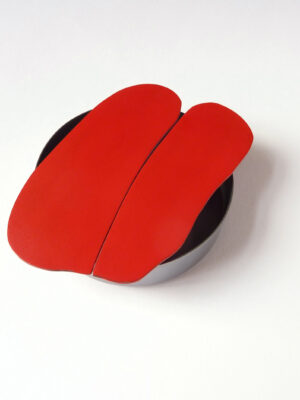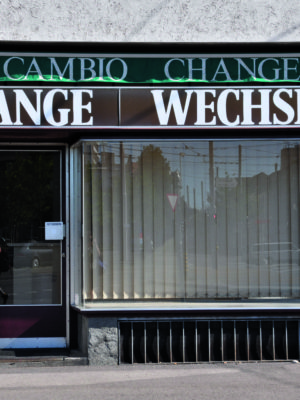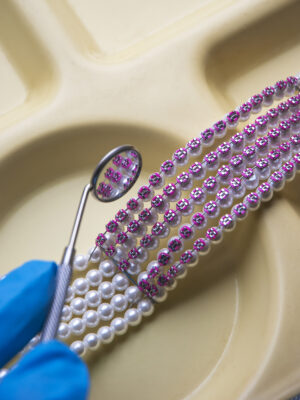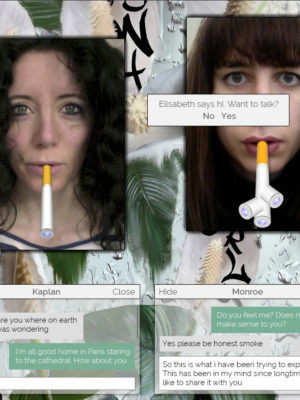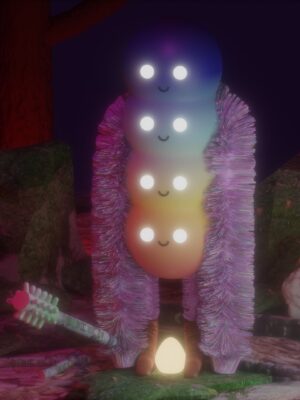Coming from Max Fröhlich, and having graduated under Herman Junger from the Munich Academy of Fine Arts in 1978 and remained in the city ever since, she has witnessed much of the development of the field personally. Yet it is interesting to note that despite being a favourite of aficionados, she is also one of the female protagonists of the field; newcomers may go years before encountering her work. She eschews public engagements, and though the subject matter of her work is notoriously personal, it yet speaks to a mysterious and simmering core of emotion to which we can all relate. For the occasion of this celebration of lifetime achievement, we spoke with both Therese Hilbert and the curator of this long distinguished exhibition series, Dr. Petra Hölscher, about what it means for both the community and those it distinguishes.
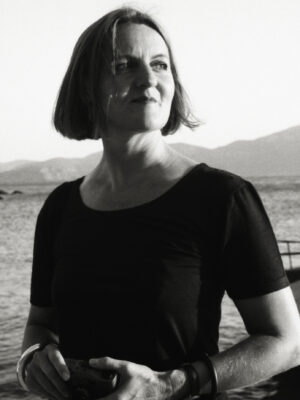
Margaret Munchheimer: Can you share a bit about how you see the position of the exposition in relation to the many aspects of the Munich Schmuck saison? What do you think it means for an artist to receive this honour, and what are your main objectives in how it is curated?
Petra Hölscher: We began in 2006 with the exhibition Hermann Jünger- Found Objects, to pay tribute to the protagonists of this still relatively young, contemporary form of jewellery. The unbelievable level of interest jewellery had brought to the 2004 opening of the Danner Rotunde, was again repeated at Hermann Jünger- the house was packed with jewellery enthusiasts. We had hoped for that, but no one could really have predicted it. It was then that we resolved to continue. The exhibition concept was simple from the start- we would show a single artist’s complete works. But especially when he/she is still active, there can still be hurdles.
To be clear, it isn’t about ultimately having every object ever made lying in the showcase. Early works simply help to understand the artistic path that has been covered. Who knew, for example, that Therese Hilbert had also worked with plastic? It is a great surprise then when you discover them and they have lost none of their original power and attraction, but have developed a certain timelessness. That was my own experience during the preparation for the exhibition, as I first saw the little apple half with its flawless red skin and the kitsch apple cast in transparent plastic. It was one of those very special, magical moments. Today that little pendant is a piece in our permanent jewellery collection, which I’m very happy about.
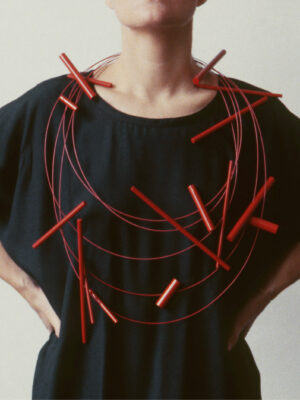
But back to your question. As the idea hung in the air, to do an annual jewellery exposition the city of Munich was beginning to fill up with jewellery events and exhibitions, in every shuttered gallery, empty shop or unused bowling alley, which mostly consisted of newly emerging contemporary artists in search of a new audience. The founders of this type of jewellery however, meaning those already active in the 1950’s, 60’s and 70’s, were seldomly seen in these exhibitions, if at all. But what does it mean to shut out history completely? How does one evaluate without it? Can we really understand the new and the novel? So from the beginning our focus lied on the initiators of modern contemporary jewellery. We wanted to draw attention to their role in the early days and show the freedom gained in the field through their work. And finally we wanted to celebrate and honour them by means of a museum. What could be more obvious than the Piano Nobile in the Pinakothek der Moderne- directly under the spectacular glass roof? Idea and location came together perfectly.
Also the international nature of the jewellery movement which remains a defining characteristic of the genre, had to be demonstrated- after Herman Jünger followed the Dutch artist Gijs Bakker, after him, the Italian, Giampaolo Babetto, then Austrian Peter Skubic, the former East German Dorothea Pruhl, American Thomas Gentille and so on. And because after an exhibition nothing but the memories remain, a publication created under scientific auspices was part of it from the beginning. Every one of these publications can now be a basis for an as yet unwritten history of the jewellery movement since the 1960’s.
‘Where the inspiration comes from is actually not so important. It’s about what you do with it. Live actively, keep your eyes open, stay curious. For me it seems the least fruitful to take inspiration from other jewellery artists.’
MM: With regards to Therese Hilbert specifically, it is almost uncanny how underrepresented her name is for so many practitioners, considering the length of her career and the space she has occupied in that world practically since its inception. Can you share a bit about the decision to dedicate a show to her?
PH: That’s exactly it. And it is impossible to understand. Looking around, Hilbert’s artistic language is truly unique in the greater jewellery family tree. Who can say that? Not many. The processing of the materials is of course perfect. The same is true of the forms. They leave nothing to chance. Her work speaks of an incredible curiosity, an insatiable hunger for the seen and felt, for smells and materials, for the obvious and the hidden.
We are talking about a woman who, as a young artist at the beginning of her career, was awarded with great honours- she was one of the first ever to receive the Herbert Hofmann Prize. It was 1974 and Therese Hilbert was still a student at his Munich Academy! Fritz Falk invited her in 1979 for a solo show at Jewellery Museum in Pforzheim, and although her daughter Miriam was then at the exciting age of three just beginning to really discover the world, the Pforzheim exhibition was exactly as the one we are showing today: prepared with the greatest perfection and seriousness with nothing, absolutely nothing, left to chance.
With work that wants to be discovered. For which you must take your time. If you don’t take the time to look, you will find it hard to understand them, much less the artist Therese Hilbert herself. She said from early on, rings and brooches were her words, and nothing more was needed. Though there may be work that is anything but consumable in a conversational tone. And as I see it, that is also a form of sustainability, that an artist offers us. Time to invest, not inrushing through and believing to have seen and understood everything. To grapple with wonderful titles such as ‘Pain’,‘Little Clouds’, ‘Emotions’ or the ‘Secret Places’ which you begin to fill in with your own associations. Perhaps that is why Hilbert names some pieces ‘Vessels’. The artist gives us not only something decorative for the hand. She gives us moments for ourselves. But isn’t that what good art is supposed to do?
And that is the crook in our perception, if I may say. Therese Hilbert has been seen in the most renowned national and international galleries, in solo and group exhibitions- not once or twice but countless times. Still all of that was not enough to really make jewellery followers aware of her. That is something Die Neue Sammlung aims to change with the exhibition, ‘Therese Hilbert. ROT’.
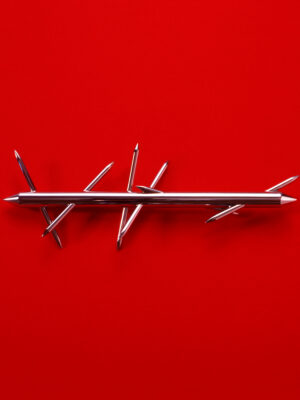
MM: Therese, In the interview with AJF, you liken the artistic process to the cycles of dormancy and eruption of the volcano, with a quote from**Eugène Ionesco and its significance in your work/life. You also mention that an artist can take 10 years before their work is developed enough to present with real strength. Both are comforting thoughts for those struggling with their own doubts in the creative process. Can you talk a bit about how this archetype has helped you to reconcile your own personal ‘pairs of antagonists’, as you put it? Is the volcano still a grounding image for you?
Therese Hilbert: This quote shouldn’t really be taken too literally. Above all, it isn’t an idea meant to intimidate or frighten, because in fact the early years are immensely important. Rarely again will you have so much time to fill your backpack with technical skills, materials knowledge and joyful experimentation. It’s also a time when your network is built by meeting others who are also searching- of course, in my time without the internet. And to exercise or to learn endurance. This will serve you your entire lifetime. Because it isn’t only about the early years, it’s a lifelong pursuit. It’s fun, gives a deep sense of satisfaction and ultimately becomes an Elixir of Life. Standstill, dry spells and despair included.
MM: You are exhibiting 250 pieces, selected in close collaboration with curator Dr. Petra Holscher. What is essential for you in the selection process? How do you view this exhibition in the context of your career?
TH: The book and the exhibition are entitled, RED. It is the most emotional colour, it can be soft and warm, but also burn, injure and destroy. It is never indifferent and can range from glowing orange to purple and almost violet. The exhibition and especially the book are divided into two main sections and are structured chronologically overall. Many of my most important and well-known works are on display, it is a journey through my life. The first part spans works from 1966-2003. At this point there is no direct connection to the Volcano, although it was about emotion and feeling, as has so often been the case in my life. Most of the works have no title, the collections in the book however most definitely do, and these certainly offer some insight. Dornenkrone (Crown of Thorns), Unmut und Widerstand (Anger and Resistance), Dolor (Pain), Kern (Core), Emotionen (Emotions), Geheime Orte (Secret Places), Das Vertraute (The Familiar).
It comprises soft, pleasant forms, interrupted by peaks and edges, thorns, sharp corners, razor blades and throwing stars, vessels, love and fury. There is a bit of a chronological overlap with the second part, as the encounter and waxing confrontation with the theme of the Volcano had already begun in the 90’s. The publication therefore, begins with the quote from Eugène Ionesco.**
The collections are now occasionally named for the volcanoes that have inspired me, but also have names like Glut (Glow), Aus der Tiefe (From the Depths). Loud, spectacular eruptions are not of particular attraction tome – I’m drawn to the dormant and slumbering volcanoes- it is the unpredictable that excites me. A yellowish grey wisp of smoke, rumbling tones, a barely perceptible vibration, hot and corrosive soil. It can end badly. It is the same with people. For as long as I can manage, I will visit and explore certain mountains of fire in the hope that it brings me further. For me personally this exhibition is a very big, and unique event, a celebration and a highlight in my own city. To know that almost all of this work was created not even a kilometre from where the museum stands. I hope that a great many visitors come to this exhibition.
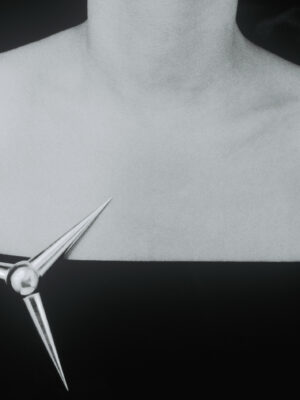
MM: The exhibition catalogue boasts texts from Heike Endter, Ellen Maurer-Zilioli, Pravu Mazumdar, to name a few. What has it been like reading these texts, and the interpretations of others?
TH: I myself do not write, give no lectures and avoid interviews. I said from quite early on, my words are the rings, the brooches and the pendant. For the book, texts were written by friends, people I know, and whom I trust. And I hoped, even suggested that these be as varied as possible. I am grateful that it also turned out that way. The texts are ultimately arranged and applied where their qualities serve best; where they belong.
MM: I’m curious what kinds of impressions and observations someone like yourself may have, who has been working in the field since the 1970’s. What kinds of shifts have you seen that still resonate for you? Is there any type of progression you think we’ve made which excites you, or things you think we could work more toward in the future? What is one thing you might tell a younger artist?
TH: I have no theorems or words of wisdom to offer. I have never given workshops or accepted teaching assignments.I am, however, very well acquainted and connected with younger colleagues. This exchange is, for me, very important. In the 70’s and 80’s, one of the absolute most important experiences was to recognize that those of us working in traditional Goldsmithing backgrounds were, above all, designing and making jewellery for the generation of our parents- jewellery which we ourselves could never have afforded. This was an important and liberating process; we began making jewellery for our generation, for our needs, and for our budgets.
Where the inspiration comes from is actually not so important. It’s about what you do with it. Live actively, keep your eyes open, stay curious- also about music, literature, and the other fine arts, including theatre and film. For me it seems the least fruitful to take inspiration from other jewellery artists.
New media, in turn, is for me simply a tool for processing information. For me the digital world does not suffice as a source of inspiration- I miss the smells, the haptics, the weight of things, the surfaces, the play of light. And on the web, most information is filtered first and foremost for efficiency; it is chiefly about Likes, about influence, money and power. And about anonymity and transience.
The opposite of what for me, jewellery is, and can be.
**For the moment, I exist. Passions slumber in me that may explode, then be held in check again. Jets of rage or joy lie within me, ready to burst and catch fire. In myself I am energy, fire, lava. I am a volcano. Most often, I am half asleep: my craters wait for this continual boiling to rise, emerge, satisfy its instincts; form my incandescent passions to pour out, ignite, and spread forth in an assault on the world.
(Eugène Ionesco)
This article is published in the printed edition of Munich Jewellery Paper, which is available for purchase through our web shop. Click on here to purchase the Paper.
